The first time we saw Mouse, it was in a post Melissa, mom of Sasha and Lux, two special needs cats we’ve featured in the past, shared on Instagram. At the time, Melissa and Heidi, Mouse’s mom, thought Mouse, like Sasha and Lux, had mucopolysaccharidosis (MPS), an extremely rare and serious condition. Because most people have never heard of MPS, we’ve featured multiple cats with various types of mucopolysaccharidoses in an effort to raise awareness about this group of inherited metabolic diseases. We reached out to Heidi — who is a veterinary student — to see if she’d like to feature Mouse, and while she agreed, she wanted to wait until she received confirmation of this suspected diagnosis.
Eventually, the results were in, and Mouse was actually diagnosed with mucolipidosis type II, or I-cell disease. Mucolipidoses, like MPS, is a group of inherited metabolic diseases, and we were eager for Heidi to share details about it with us. Not only did Heidi tell us about mucolipidosis type II, or ML II, and how it affects Mouse, but she also shared how she ended up adopting this adorable special needs cat in April 2022, circumstances that were very similar to how we adopted Mittens, our first CH kitty who inspired us to start Meow As Fluff after losing him shortly before his third birthday. We also discovered that while ML II definitely impacts Mouse’s mobility, like pretty much all of the special needs cats we’ve featured over the last six years, she’s still a pretty typical cat in spite of her condition.
We’re very grateful to Heidi for taking time out from her studies to share Mouse’s story with us, and we hope you’ll enjoy reading it as much as we did!
Meow As Fluff: How did you end up meeting Mouse?
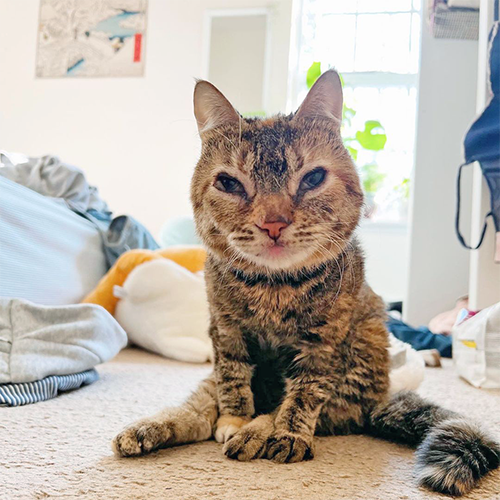
Heidi: Mouse was found at about four weeks old with her two brothers and mom in a yard in Northern California [in May 2021]. She was taken in by Hopalong Animal Rescue of Marin Humane and had to be bottle-fed because she was the runt and kept getting pushed off the nipple.

Neither of her brothers had any developmental issues but at seven weeks old, Mouse’s foster noticed that she was a classic failure-to-thrive case. I was working as a veterinary assistant at a clinic that offered low-cost spays, neuters, and medical services for Hopalong when Mouse first came as a patient. She was limping on her right front leg and we thought she was tiny for her age and odd-looking, but her vet couldn’t pinpoint exactly what was wrong with her and sent her home on pain medication.
When she came back to get spayed a few weeks later, however, we noticed that she was extremely malnourished and bloated. She couldn’t open her mouth more than a centimeter so that even with a voracious appetite, she could only manage to lick the gravy off her wet food. Given her body condition, her vets feared she might have FIP [feline infectious peritonitis] or some grave congenital abnormalities, so euthanasia was discussed.
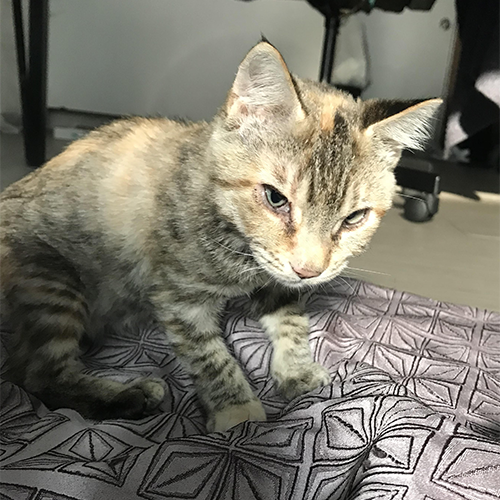
That’s when I volunteered to take Mouse home as a hospice foster. I wanted to buy her more time to figure out what was wrong with her. On the day I brought her home, she immediately settled in, played with toys, and even pooped for the first time in about three days. I knew she was full of love when I first held her in my arms and she started licking me like a puppy. In my home, Mouse showed spunk and an obvious will to live despite her shabby appearance.

My veterinary student brain became determined to find a diagnosis for her so that I can give her the best care. When I was accepted to veterinary school, I formally adopted her and brought her with me to Cornell University where we are now. Almost two years later, she is finally diagnosed with mucolipidosis type II (I-cell disease)!
MAF: Can you tell me the story behind her name?
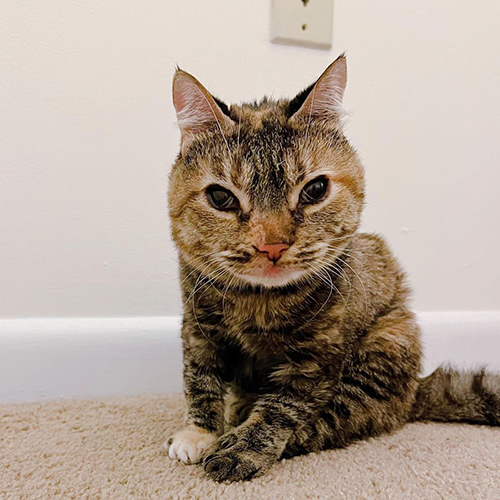
H: Mighty Mouse is actually the name her foster organization gave her! I believe she is named after a cartoon character from the 1940s. I kept the name because I thought it fit her perfectly. She’s tiny at 4.7 pounds, but she has always been a fighter. It’s kind of a long name, so I usually call her Mouse or Mousey.
MAF: What made you decide to provide a home to a cat with mucolipidosis type II?
H: She was a classic “someone take her home or she’s going to be euthanized!” case. I honestly had no idea what was wrong with her when I brought her home; I just knew I had to advocate for her. She deserved more than a death caused by unanswered questions.
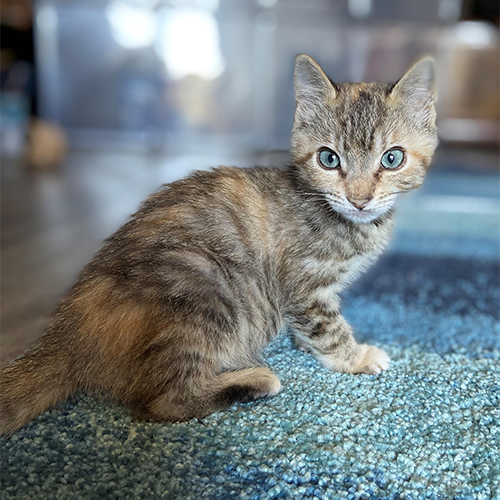
Now that I do know she has ML II though, I have no doubt that I’m the most qualified owner for her. It’s such a rare disease that most veterinarians have never even heard of it! I’m utilizing my network and resources here at Cornell to get her seen by all of the specialty departments, and we’re in contact with Dr. Casal at the University of Pennsylvania who does extensive research on lysosomal storage diseases. We’re in the process of getting her genome sequenced and are hoping to get her case published in the future.
MAF: What exactly is mucolipidosis type II (I-cell disease) and how does it affect Mouse specifically?
H: Mucolipidosis type II (I-cell disease) is a congenital metabolic disease. It’s caused by a mutation that prevents adequate production of an enzyme that is needed for the digestion of GAG proteins. The body uses GAG proteins like glucosamine and hyaluronic acid everywhere, but especially in places like our joints and eyes. That’s why Mouse has osteoarthritis and is mostly blind at such a young age.

Since four months old, she has had varying degrees of stiffness across her body. At 6-8 months old, she stopped being able to pounce on her toys and started walking with a choppier gait. She can’t jump or climb onto things, so I keep everything ground-level for her, even my own mattress! Because she has mobility issues, she is very prone to constipation and I feed her a prescription gastrointestinal health diet. She also can’t groom herself so I give her baths as needed.
Mouse’s main problem is her arthritis. She gets a small amount of maintenance pain medication daily, and we use the Assisi Loop Lounge to reduce inflammation in her joints. This device uses targeted electromagnetic pulses to stimulate natural healing in the body and is a great non-invasive way for pain management in geriatric patients.
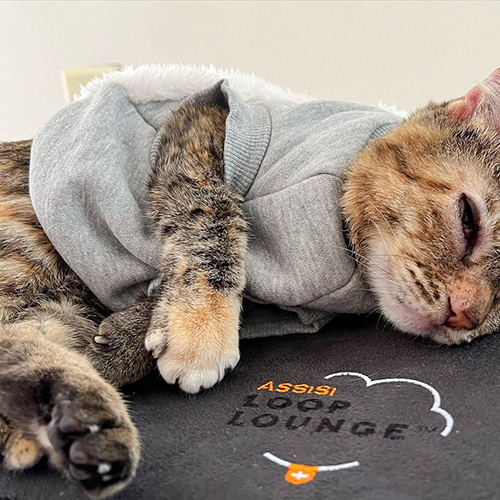
Normally, a cat with arthritis would be given joint supplements. Unfortunately, because of her condition, Mouse is unable to digest these (i.e., Cosequin, YuMove 360) that include glucosamine or other GAG proteins. Instead, I’ve opted to start her on Flexadin UC-II, a supplement that “tricks” the body’s immune cells to stop attacking the collagen present in her joints. We’re hoping that this slows down the progression of degenerative joint disease. Another thing I do to help her is by giving her massages every day and doing physical therapy exercises with her!
View this post on Instagram
MAF: What are some of the biggest misconceptions you think people have about special needs cats and specifically cats with ML II?
H: There is so much judgment from other people on how you care for your pet. A common issue I see for special needs pet owners and specifically cats with lysosomal storage disease is comments on our social media posts that we are being cruel for not euthanizing our pets. I think it’s very easy for people to make snap judgments about an animal’s quality of life based on the snippets we share. Hate comments are unavoidable when we expose our sick pet’s vulnerabilities to the public, after all.
View this post on Instagram
I wish that those people understood we are sharing these parts of our lives to spread awareness and build community, not to ask for opinions about if we should keep our pets alive or not. Many ML II and MPS cats “look odd” because facial dysmorphia is a hallmark sign of the disease. I think this leads to a misconception that they are much sicker than they actually are. People would be surprised at the very normal cat things these patients do! For example, I came home last week to Mouse with half her body in a bag of cat food I accidentally left open.
View this post on Instagram
MAF: What are some of the challenges you’ve faced as a result of Mouse having ML II?
H: The hardest thing about Mouse’s condition is that I have no idea how long she has left with me in this world. Sadly enough, ML-II is a poorly studied disease as it is so rare, and current literature says that feline patients live to only 7-8 months of age. Mouse turns two years old in April, so I think we’re doing a good job! Every time she hiccups a little strangely or is more quiet than her usual self though, I get anxious about her health. I think many owners with special needs pets can relate to this.
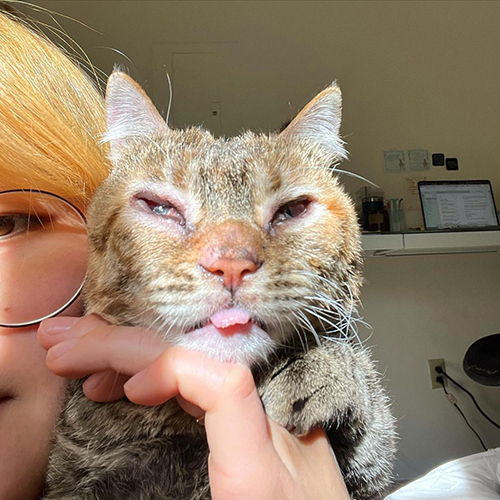
Frankly, I don’t think anything about caring for Mouse on the medical side is difficult or challenging for me. I’d happily be her legs and her eyes for as long as she feels comfortable hanging around. I’ve also been so blessed to be surrounded by amazing veterinarians at Cornell University where I am a 1st-year veterinary student. She’s currently been seen by the Neurology, Sports Medicine, and Ophthalmology departments and we have plans to take her to Cardiology, too. Everyone has been so supportive and interested in her care and it warms my heart that Mouse has a strong community behind her.
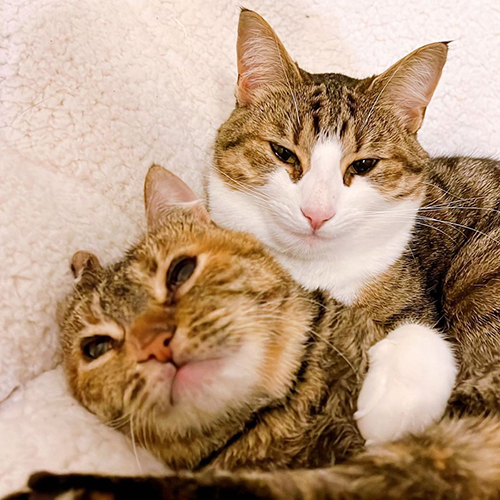
It’s scary that we don’t have an estimated lifespan, but it makes me all the more grateful for every single day I spent with Mouse. I wouldn’t trade her for any other cat in the world.
MAF: What do you wish more people knew about special needs cats, particularly cats with ML II?
H: I don’t think we talk about anticipatory grief enough. Special needs pet owners often struggle with the anxiety that comes with the expectation that their chronically sick pet will eventually be sicker. I can’t tell you the number of times I’ve had a mental breakdown just thinking about when Mouse can’t walk anymore or gets so sick that I have to say goodbye to her. Meanwhile, she’s happily purring beside me.
View this post on Instagram
The truth is, it’s mentally, emotionally, physically, and psychologically draining to be a caretaker for a sick pet. It involves a lot of time and consideration for things you would never think would be a problem for “normal” pets. I wish that people knew how much painful love is involved with having a special needs companion.
MAF: What are some of Mouse’s favorite activities?
H: Mouse loves cuddles. Her love languages are physical touch and quality time, so she always wants to hang around while I’m doing things. I can still remember the first time that Mouse fell asleep on my foot while I was doing the dishes. When I’m knitting, she uses the yarn ball as a pillow. I also like to let her sniff the ingredients I’m cooking with. Back when I had a balcony, she loved coming out with me to water my plants. She just likes to hang around!

She also loves food! Something about liquid cat treats like Churu turns her into the Hulk and she will try to yank the tube out of my hand every time.
MAF: What does she mean to you?
H: Mouse is my heart cat. She brings out the best in me and I bring out the best in her. I’m not sure there is a word to even describe the bond that we have. She just makes me want to be the best veterinarian I can be in the future for animals like her.
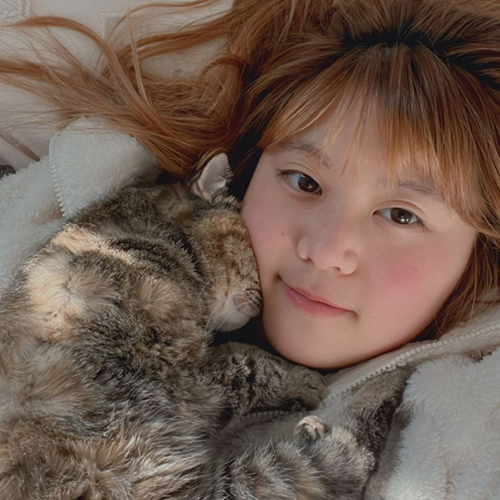
Sometimes on my worst days, all I have to do is hold her little paw and I remember that life is quite simple at the end of the day. I focus on what matters in the present moment when I’m with her. I’m so grateful she’s mine.
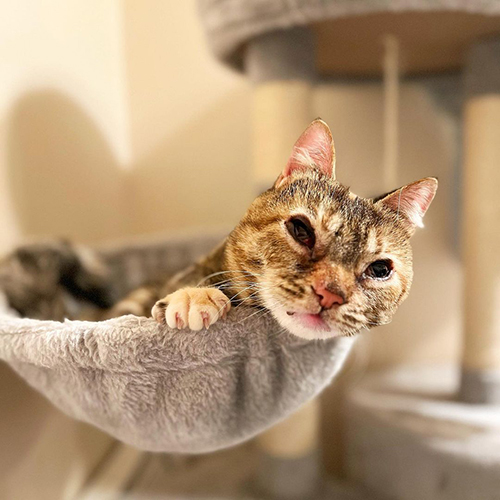
To learn more about this gorgeous girl, you can follow Mouse on Instagram.


